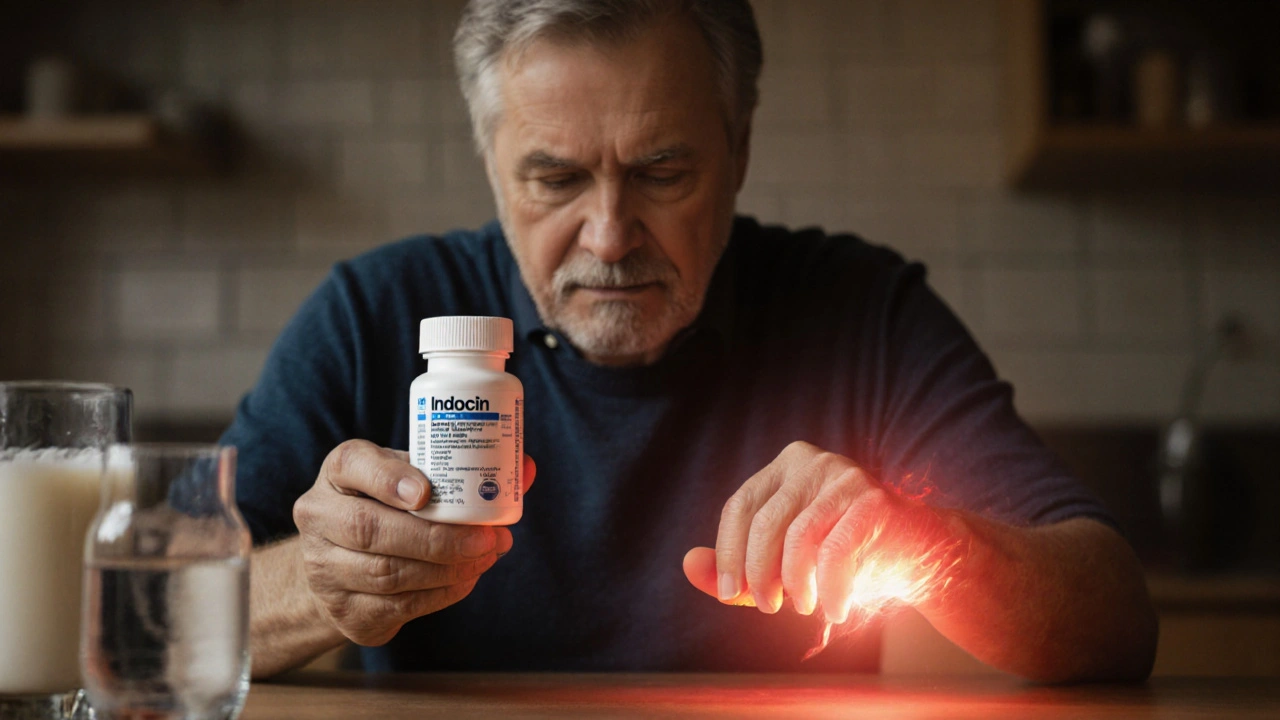NSAID Comparison Tool
Use this tool to compare key attributes of Indocin and common NSAID alternatives. Select a drug to see detailed information.
Indomethacin (Indocin)
Typical Dose: 25–50 mg 2–3×/day
COX Selectivity: Non-selective (COX-1 & COX-2)
Duration of Action: 4–6 hours
GI Risk: High
Cardiovascular Risk: Moderate
| Drug | Typical Dose | COX Selectivity | Duration of Action | GI Risk | Cardiovascular Risk |
|---|---|---|---|---|---|
| Indomethacin | 25–50 mg 2–3×/day | Non-selective (COX-1 & COX-2) | 4–6 hours | High | Moderate |
| Naproxen | 250–500 mg 1–2×/day | Non-selective | 8–12 hours | Moderate | Low-to-moderate |
| Ibuprofen | 200–400 mg 3–4×/day | Non-selective | 4–6 hours | Moderate | Low-to-moderate |
| Celecoxib | 100–200 mg 1×/day | COX-2 selective | 12–24 hours | Low | Higher (especially in patients with existing heart disease) |
| Diclofenac | 50–75 mg 2–3×/day | Preferential COX-2 | 6–8 hours | Moderate | Higher (particularly topical vs oral) |
| Meloxicam | 7.5–15 mg 1×/day | COX-2 preferential | 24 hours | Low-to-moderate | Moderate |
When you’ve been prescribed Indocin for arthritis, gout, or other painful inflammation, you might wonder if there’s a safer or more convenient option. This guide breaks down how Indocin works, why patients look for alternatives, and how the most popular NSAIDs stack up against each other.
Key Takeaways
- Indocin is a potent non‑steroidal anti‑inflammatory drug (NSAID) with strong pain‑relieving power but a higher risk of stomach irritation.
- Common alternatives-naproxen, ibuprofen, celecoxib, diclofenac, and meloxicam-vary in duration, gastrointestinal safety, and cardiovascular profile.
- Choosing the right drug depends on your condition, stomach health, heart risk, and how often you need dosing.
- Switching drugs should be done under a clinician’s guidance to avoid rebound pain or drug interactions.
- Always consider the lowest effective dose for the shortest time needed.
What Is Indocin (Indomethacin)?
Indomethacin is a prescription NSAID that blocks cyclooxygenase (COX) enzymes, which produce prostaglandins-the chemicals that cause pain, swelling, and fever. By inhibiting both COX‑1 and COX‑2, Indomethacin delivers fast, strong relief for conditions like rheumatoid arthritis, ankylosing spondylitis, and acute gout attacks.
Typical doses range from 25mg to 50mg two or three times daily. The drug’s half‑life is about 4.5hours, so it often needs multiple daily doses to keep pain at bay.
Why Look for Alternatives?
Indomethacin’s strength comes with trade‑offs. About 20‑30% of users experience gastrointestinal (GI) side effects such as stomach upset, ulcers, or bleeding. It can also raise blood pressure and, in rare cases, affect kidney function.
Patients with a history of ulcers, chronic heart disease, or who need long‑term therapy frequently ask for alternatives that are easier on the gut, require fewer daily pills, or carry a lower cardiovascular risk.
Head‑to‑Head Comparison of Popular NSAID Alternatives
| Drug | Typical Dose | COX Selectivity | Duration of Action | GI Risk | Cardiovascular Risk |
|---|---|---|---|---|---|
| Indomethacin | 25‑50mg 2-3×/day | Non‑selective (COX‑1&COX‑2) | 4‑6hours | High | Moderate |
| Naproxen | 250‑500mg 1‑2×/day | Non‑selective | 8‑12hours | Moderate | Low‑to‑moderate |
| Ibuprofen | 200‑400mg 3‑4×/day | Non‑selective | 4‑6hours | Moderate | Low‑to‑moderate |
| Celecoxib | 100‑200mg 1×/day | COX‑2 selective | 12‑24hours | Low | Higher (especially in patients with existing heart disease) |
| Diclofenac | 50‑75mg 2-3×/day | Preferential COX‑2 | 6‑8hours | Moderate | Higher (particularly topical vs oral) |
| Meloxicam | 7.5‑15mg 1×/day | COX‑2 preferential | 24hours | Low‑to‑moderate | Moderate |
How to Pick the Right NSAID for You
Think of the decision as a balance sheet: add the benefits you need (pain control, dosing convenience) and subtract the risks you can’t tolerate (stomach ulcer, heart strain).
- Stomach‑sensitive patients - Favor COX‑2 selective options like celecoxib or meloxicam, or add a proton‑pump inhibitor (PPI) if a non‑selective drug is necessary.
- Heart‑risk patients - Naproxen has the most favorable cardiovascular profile among non‑selective NSAIDs. Avoid chronic high‑dose diclofenac or celecoxib without cardiology clearance.
- Need for once‑daily dosing - Meloxicam, celecoxib, or extended‑release naproxen keep you from remembering multiple pills.
- Acute gout attacks - Indomethacin remains a gold standard for fast relief, but if GI risk is high, a low‑dose colchicine regimen or corticosteroid burst may be safer.

Safety Checklist Before Switching
- Review your current medical history: ulcer disease, hypertension, kidney function, and heart conditions.
- Check all medications for interactions (e.g., anticoagulants, SSRIs, lithium).
- Discuss the plan with your prescriber. A gradual taper off Indocin can prevent rebound inflammation.
- Consider protective agents: a PPI (omeprazole) or misoprostol for patients staying on a non‑selective NSAID.
- Monitor symptoms for the first two weeks: any new stomach pain, dark stools, swelling, or blood pressure rise should trigger a call to the doctor.
Practical Tips for Managing Pain While You Transition
While you’re moving from Indocin to a new drug, keep these habits in mind:
- Take the medication with food or a full glass of milk to soften stomach irritation.
- Stay hydrated - adequate water helps kidney clearance of NSAIDs.
- Track your pain scores in a simple diary; noting the time of dose and relief level helps the clinician fine‑tune the regimen.
- If you need extra short‑term relief, a low‑dose acetaminophen (up to 3g/day) can be combined safely with most NSAIDs.
Frequently Asked Questions
Can I take ibuprofen instead of Indocin for arthritis?
Yes, ibuprofen provides comparable pain relief for mild‑to‑moderate arthritis, but you may need to take it three to four times a day. If stomach upset is a concern, a daily PPI is advisable.
Is celecoxib safer for my ulcer history?
Celecoxib’s COX‑2 selectivity means it spares the stomach lining more than non‑selective NSAIDs. It’s often the first choice for patients with prior ulcers, though regular monitoring of blood pressure is still needed.
What should I do if I miss a dose of Indocin?
Take the missed dose as soon as you remember, unless it’s almost time for the next scheduled dose. In that case, skip the missed one and resume your normal schedule. Never double‑dose.
Are topical NSAIDs a good alternative?
For localized joint pain, topical diclofenac gels or creams can provide relief with far less systemic exposure, reducing GI and heart risks. They’re not as strong for widespread inflammation, though.
How long can I stay on an NSAID safely?
Short‑term use (a few weeks) is generally safe for most adults. Chronic therapy beyond three months should be re‑evaluated with labs (CBC, liver, kidney) and possibly a gastro‑protective strategy.
Bottom line: Indocin works fast and powerfully, but its GI and cardiovascular profile pushes many patients toward gentler options. By weighing dose frequency, stomach safety, and heart health, you can land on an NSAID that eases pain without unwanted side effects. Always involve your healthcare provider before making any switch.








Reading through that table feels like watching a fireworks show inside your gut – the high GI risk of Indocin explodes like a volcano, while the more laid‑back celecoxib tiptoes around the stomach like a ballerina on clouds.
While the guide glorifies Indocin’s swift analgesic punch, the empirical evidence unequivocally demonstrates that its high gastrointestinal toxicity outweighs any marginal benefit over naproxen or ibuprofen for chronic arthritic management; a rigorous risk‑benefit analysis mandates preferential selection of agents with superior cardiac safety profiles.
Hey fellow pain‑fighters, if you’re dancing with Indocin and the stomach starts chanting protests, remember you have a whole squad of alternatives ready to step in – a little meloxicam or celecoxib can keep you moving without that gut‑burn encore.
Got to say, the table’s spot‑on – love the clear breakdown. 👍 Just a heads‑up: tossing a PPI in with any non‑selective NSAID can really smooth out that stomach drama. 😜
The ethical dimension of prescribing a drug that trashed the gut in 30% of patients cannot be ignored; we must weigh the philosopher’s principle of "do no harm" against the fleeting relief that Indocin offers, especially when gentler COX‑2 selectors sit patiently on the shelf.
When we examine the comparative data for Indocin versus its NSAID cousins, several layers of clinical nuance emerge that merit a methodical unpacking. First, the pharmacokinetic profile of indomethacin, with its brief half‑life of approximately 4.5 hours, necessitates multiple daily dosing, which can compromise adherence in patients juggling complex regimens. Second, the non‑selective inhibition of both COX‑1 and COX‑2 enzymes underlies its potent anti‑inflammatory potency, yet simultaneously erodes gastric mucosal defenses, precipitating a high incidence of ulceration and bleeding. Third, while naproxen’s extended duration of action (8–12 hours) offers a more convenient dosing schedule, its moderate GI risk still surpasses that of COX‑2 selective agents such as celecoxib, which, despite a lower gastrointestinal profile, carries a heightened cardiovascular warning that cannot be dismissed. Fourth, ibuprofen’s moderate GI and cardiovascular risk profile makes it a reasonable middle ground, though the need for four daily doses can be a practical hindrance. Fifth, diclofenac’s preferential COX‑2 affinity does not exempt it from cardiovascular concerns, especially in chronic use, and topical formulations, while reducing systemic exposure, may not suffice for severe systemic inflammation. Sixth, meloxicam’s once‑daily dosing and low‑to‑moderate GI risk present an appealing option for patients seeking simplicity, though its modest cardiovascular risk remains comparable to indomethacin. Seventh, the role of adjunctive gastro‑protective agents, such as proton‑pump inhibitors, can mitigate some gastrointestinal hazards when non‑selective NSAIDs are indispensable. Eighth, patient‑specific factors-such as prior ulcer disease, hypertension, renal function, and concomitant anticoagulant therapy-must steer the therapeutic choice. Ninth, the economic dimension cannot be ignored; generic ibuprofen and naproxen are often more affordable than branded COX‑2 inhibitors, influencing adherence. Tenth, clinicians should educate patients on recognizing early signs of GI bleeding, such as melena or unexplained anemia, to prompt timely intervention. Eleventh, regular monitoring of blood pressure and renal parameters is advisable when long‑term NSAID therapy is required. Twelfth, the potential for drug interactions, especially with SSRIs, anticoagulants, or lithium, underscores the importance of a comprehensive medication review. Thirteenth, for acute gout flares, indomethacin remains a gold‑standard due to its rapid onset, yet low‑dose colchicine or corticosteroid bursts may be safer for high‑risk patients. Fourteenth, lifestyle modifications, including dietary adjustments and weight management, can synergize with pharmacologic therapy to reduce joint stress. Fifteenth, a shared decision‑making model empowers patients to balance efficacy against safety, fostering adherence and better outcomes. Finally, ongoing research into selective COX‑2 modulators and novel anti‑inflammatory pathways holds promise for future therapies that might finally decouple potency from toxicity.
Let’s keep the momentum up! If you’re dodging stomach burn, pair any non‑selective NSAID with a PPI – instant armor for your gut. And remember, consistency beats occasional high‑dose heroics every time.
The cardiovascular risk nuance is spot on; many overlook that naproxen’s lower heart danger makes it a safe fallback when aspirin is already in the mix.
Upon meticulous examination of the presented data, it becomes evident that the author has employed a reductive categorical framework, thereby obscuring the intricate pharmacodynamic differentials that exist between COX‑1 and COX‑2 inhibition; such an oversimplification may inadvertently mislead clinicians seeking granular therapeutic insight.
The article cherry‑picks the low‑risk profile of celecoxib while conveniently glossing over its notorious cardiovascular warnings, presenting a biased narrative that serves no one.
Meh, same old table.
Observe the superficial gloss of this comparison; beneath the polished rows lies a dearth of patient‑centric discussion, reducing the discourse to mere academic trivia.
Let us recognize that each NSAID carries its own balance of efficacy and risk, and a respectful dialogue that honors individual patient contexts can bridge the divide between over‑enthusiastic proponents and wary skeptics.
From a pharmacodynamic perspective, the non‑selective inhibition pattern of indomethacin yields a broader prostaglandin suppression, yet this mechanistic advantage is offset by its elevated GI toxicity, underscoring the necessity for judicious agent selection in chronic pain protocols.
I totally get the worry about stomach issues – swapping to a COX‑2 selective pill with a PPI backup can make a world of difference without sacrificing relief.
i dont think you need that many pills.
I would add that monitoring renal function periodically is prudent, especially when patients are on higher‑dose indomethacin regimens; this simple step can preempt serious complications.
Love the chart 😊 makes it super easy to compare at a glance.
👍
this guide is a total nonsense, u should read the original studies.